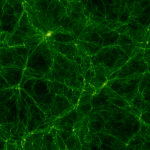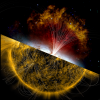
Monthly Notices of the Royal Astronomical Society
Volume 480, Issue 1, 11 October 2018, Pages 623-628
Autores: Costa, A.a,b , Schneiter, M. a,b,c, Zurbriggen, E.a,b,d
a Consejo Nacional de Investigaciones Científicas y Técnicas (CONICET), Argentina
b Instituto de Astronomía Teórica y Experimental (IATE), Córdoba, Argentina
c Facultad de Ciencias Exactas, Físicas y Naturales, Universidad Nacional de Córdoba (UNC), Córdoba, Argentina
d Observatorio Astronómico de Córdoba (OAC), Universidad Nacional de Córdoba, Córdoba, Argentina
Abstract
Assuming the thin flux tube approximation, we introduce an analytical model that contemplates the presence of a non-isothermal temperature, a varying magnetic field, and a non-uniform stratified medium in hydrostatic equilibrium due to a constant gravity acceleration. This allows the study of slow magnetoacoustic cut-offperiods across the solar transition region, from the base of the solar chromosphere to the lower corona. The used temperature profile approaches the solar atmospheric model of G18. The periods obtained are consistent with observations. Similar to the acoustic cut-offperiods, the resulting magnetoacoustic gravity ones follow the sharp temperature profile, but shifted towards larger heights; in other words, at a given height the magnetoacoustic cut-offperiod is significantly lower than the corresponding acoustic one. Along a given longitude of an inclined thin magnetic tube, the greater its inclination the softer the temperature gradient it crosses. Changes in the magnetic field intensity do not significantly modify the periods at the coronal level but modulate the values below the transition region within periods between ~[2-6] min. Within the limitations of our model, we show that monochromatic oscillations of the solar atmosphere are the atmospheric response at its natural frequency to random or impulsive perturbations, and not a consequence of the forcing from the photosphere. © 2018 The Author(s). Published by Oxford University Press on behalf of the Royal Astronomical Society.








